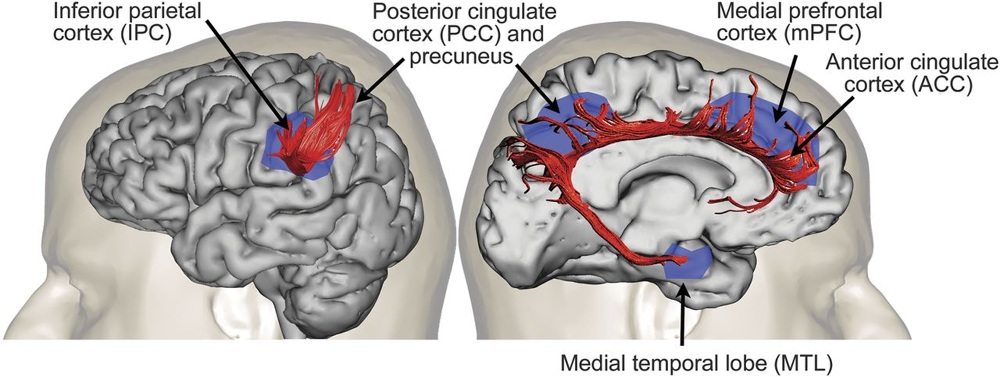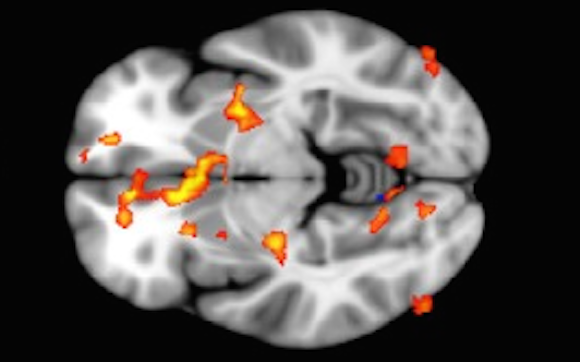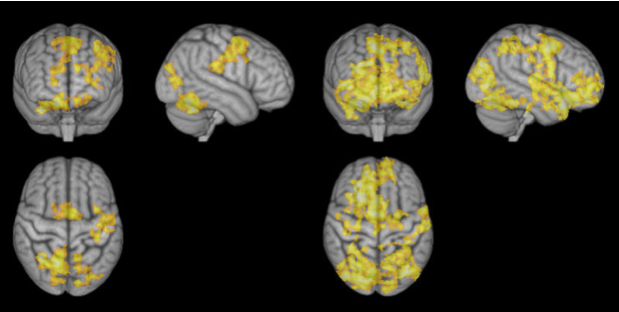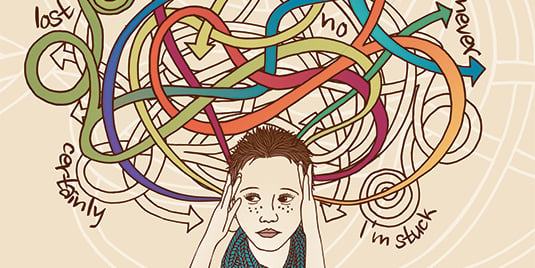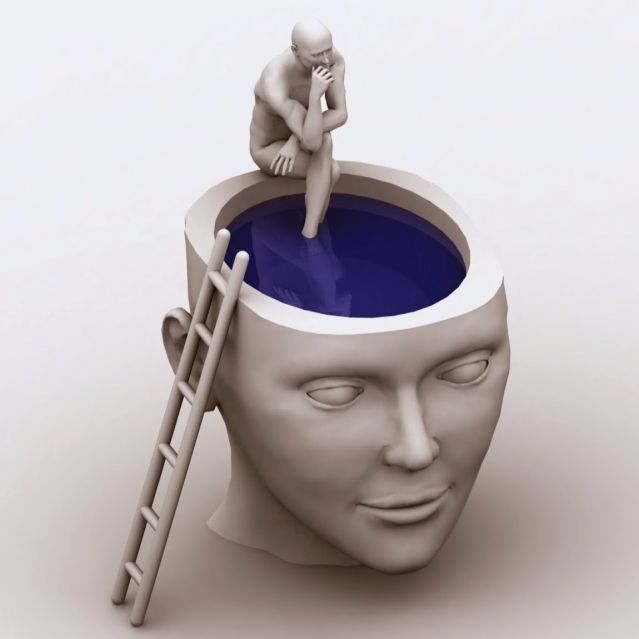Three really great articles that may be incredibly helpful to those who have difficulty “turning off their brain” and/or negative ruminating thoughts.
Just as an aside - when combined with psilocybin therapy the effect is increased exponentially and is longer lasting - getting out of the “rut” people get stuck in is not always as easy as just meditating or going for a walk.
Entheogenic substances actually physically decrease blood flow to the DMN and “turn off” (or have a “reset” quality to) the areas of the brain responsible for negative ruminating patterns.
Not surprisingly being in such negative states of mind is incredibly self-centered or ego-centric - not in the way that a narcissist exhibits such behaviors but presented by the inability or reduced ability to stay out of their own heads or ego - those severely stuck in depressive or anxious rumination will have difficulty with working memory also as the brain is too preoccupied with the rumination to properly store potentially important information.
The DMN is the seat of the ego - thus it is reduced as well by such activities and substances - this can account for personal experiences where an ego reduction or dissolution is expressed.
Such activities or substances increase neuroplasticity allowing positive changes to take hold and create new pathways much easier.
When all such avenues are used properly together, it can and does break people out of deep depressive/anxiety/PTSD/OCD/chronic pain/addiction cycles that have existed for years or even decades.
Enjoy!

Why Can’t I Stop Worrying?
The answer may be in the Default Mode Network.
You are at the beach on vacation, the breeze gently wafts around you; the ocean shimmers.
Your mind wanders: about the work that will have piled up during your time off; about your boss who is a fault-finding micromanager; or, that situation with your children, your spouse, your parent, the bills… Instead of feeling relaxed, you are now worried and wound up.
Your noisy brain has hijacked you away from experiencing the present.
What causes this “noisy” brain?
It may be the
default mode network (DMN).
The DMN is a relatively recently hypothesized network of brain regions.
It is activated when we aren’t concentrating on anything in particular.
It is deactivated when we are focused or concentrating.
It was discovered by scientists who noticed that when subjects were asked to rest quietly between goal-oriented tasks, they showed more than expected brain activity (assessed by functional MRI or positron-emission tomography) for a resting state.
Why would the brain be churning like this when resting?
Not all neuroscientists agree what this default brain activity during the resting state means.
Some neuroscientists hypothesize that the DMN brain regions include the prefrontal cortex (which is involved in processing and interpreting information about one’s experiences), the dorsomedial cortex (involved in forming beliefs about others), and the temporal lobe areas (region of the brain where new and old memories are formed).
The scientists believe that these areas are activated when you think about yourself and about others in relation to you; therefore, the DMN directs how you store your memories and categorizes your thoughts about the past, the present, and the future.
In other words, some researchers believed that the DMN is where our sense of self or the ego occurs.
This is the positive, organizing aspect of the DMN. However, there is also a negative aspect of the DMN.
The negative is that activation of the DMN pulls the person away from the “here and now.”
The DMN is activated during mind wandering.
For example, instead of experiencing all the aspects of being on the beach during your vacation, your mind is directed to the stuff inside your head.
If the “data” you have laid down in your DMN
memory regarding the thinking of yourself or others are pessimistic or
fear-based, when you are “inside your head”--it will be unpleasant for you.
In addition, the DMN can be overactivated: this is called “hyperconnectivity” and is associated with rumination.
In other words, your mind will be replaying negative events over and over, or
catastrophizing, or stimulating self-doubt and self-blame.
Not surprisingly, some studies have found that individuals who experience clinical
depression have DMN overactivation.
DMN hyperconnectivity has also been associated with
anxiety.
As an analogy, think of a forest with a well-worn pathway through it.
The DMN is sort of like that: a well-worn neurologic pathway that you take when your mind isn’t occupied.
Mind-wandering can lead to worry,
pessimism, and obsessing over what might go wrong and becomes “the default mode.”
So, how can you “deactivate” this DMN “worry” route? Here are some suggestions.
- Altering consciousness: Interestingly, some researchers have found that among experienced meditators, mindfulness lowered DMN activity. In other words, this type of meditation quieted the brain.
- Mindfulness at the most basic level is essentially taking control over your mind. One way to counteract the DMN “worry tract” is when the mind wanders, bring it back to the moment. By simply paying attention to the sights, smells, and sounds around you, you experience the “here and now.”
- Change the route: Instead of the well-worn worry path, direct the wandering to think of obstacles as opportunities and the unknown as exciting new frontiers. In order words, think outside the box. For example, rather than letting a micromanaging boss become a worry instigator, flip that to a motivating force for you to brainstorm the type of work and situation where you could flourish instead of flounder.
- This type of thinking is called a “task positive network.” Neuroscientists have found that obsessing about the negative, or “depressive rumination,” is associated with higher levels of DMN activation and lower levels of a task-positive network; particularly, in those who suffer from clinical depression.
- Creative thinking: Move outside the well-worn DMN into other modes of perception. You may want to explore your environment through only the visual; e.g., doing something non-verbal such as painting but in an abstract way.
- Have you ever looked at what young children draw and paint? A purple monkey wearing yellow mittens; a dragon-lion with blue wings and a red tail; abstract shapes with eyes and long pointy ears. Thinking outside the box means moving out of the old neurologic routes into other ways of perceiving the world around you.
- Change the channel: Mind-wander into self-reflection that is intentionally positive. Psychologists would call this “adaptive” rather than “maladaptive” thinking. For example, if your mind wanders into mental narratives of your short-comings, change the channel to a positive memory.
- Psychologist Martin Seligman called these “signature strengths.” Daydream about your successes; daydream about the future where you prevail and thrive.
The DMN can become neurologic “ruts” that are deeply “grooved” by habit.
Many of us wander into worry as if we were on autopilot.
In other words, we don’t think about what we are thinking about.
Lowering the noise in our brains is a challenge, but not an insurmountable one.
Quieting the mind offers not just a peaceful state but opens dimensions of perception.
_____________________
References
Brewer, J. A., Worhunsky, P. D., Gray, J. R., Tan, Y., Weber, J., & Kober, H. (2011). Meditation experience is associated with differences in default mode network activity and connectivity. Proceedings of the National Academy of Sciences, 108, 20254-20259. doi.org/10.1073/pnas.1112029108
Hamilton, J. P., Furman, D. J., Chang, C., Thomason, M. E., Dennis, E., & Gotlin, I. H. (2011). Default-mode and task-positive network activity in Major Depressive Disorder: Implications for adaptive and maladaptive rumination. Biological Psychiatry, 70, 327-333. doi:10.1016/j.biopsych.2011.02.003
Raichle, M. E., MacLeod, A. M., Synder, A. Z., Powers, W. J., Gusnard, D. A., & Shulman, G. L. (2001). A default mode of brain function. Proceedings of the National Academy of Sciences, 98, 676-682. doi.org/10.1073/pnas.98.2.676
Seligman, M. E. P., Rashid, T., & Parks, A. C. (2006). Positive psychotherapy. American Psychologist, 61, 774-788. doi: 10.1037/0003-066X.61.8.774
________________________________________________________________________________________________________________
________________________________________________________________________________________________________________
Stuck in Negative Thinking? It Could Be Your Brain
And 5 ways to break the depressive thinking cycle.
We may regret the past, judge ourselves as unworthy or unlovable, blame others for our problems, or anticipate a bleak future.
These ruminative cycles exacerbate feelings of sadness, shame or anger, and interfere with motivation to try to move on or actively solve problems. Depressive thought cycles like these seem to be entrenched, and are very difficult to break, even when we try to use logic to refute the negative thinking.
Ruminative thinking makes depression worse and is even a predictor of subsequent depression in non-depressed people and of relapse in previously depressed people.
What Brain Processes Underly Depressive Rumination?
Recently, scientists at Stanford University have begun to uncover what might be going on in our brains during depressive rumination.
A July 2015 study, “Depressive Rumination, the Default-Mode Network, and the Dark Matter of Clinical Neuroscience,” authored by J. Paul Hamilton and colleagues was published in the journal Biological Psychiatry.
This study statistically combined several previous research studies using meta-analytic tools and came to the conclusion that depressed people had increased functional brain connections between two different brain areas:
- The default mode network (DMN) and
- The subgenual prefrontal cortex (PFC)
The DMN is a part of the brain that is active when we self-reflect, worry, daydream, or reminisce.
It has been described as facilitating a wakeful state of rest in which the mind naturally wanders.
The DMN refers to a network of interacting brain regions including the posterior cingulate cortex (PCC), anterior cingulate cortex (ACC), and ventral prefrontal cortex (PFC).
The subgenual PFC helps to direct the DMN towards reflecting on and trying to solve the problems which the brain considers most pressing or important for survival.
This process can be functional if such reflection actually leads to finding new answers or taking effective action.
In depression, the subgenual PFC seems to go haywire, hijacking normal self-reflection into a state of mind that is negative, self-focused, and withdrawn. In this state of mind, we continually reflect on our problems in a repetitive, negatively-toned way, but are de-motivated to actually engage with the world so as to solve those problems.
Depressed people tend to go on and on talking about themselves and their problems, yet seem mentally stuck and unable to move forward.
The fact that they can’t just “snap out of it” is consistent with the idea that a dysfunctional brain network may be involved in depressive thinking.
What You Can Do to Combat Depressive, Ruminative Thinking
Try Transcranial Magnetic Imagining
Some preliminary research shows that this intervention may change abnormal functional connectivity within the DMN.
Deliberately Focus on a Task
It doesn’t matter whether it’s tidying your closets, doing the laundry, or doing a crossword puzzle, getting an “on-task” focus can de-activate the DMN and instead activate the “on-task” areas of the brain.
Take a Walk in Nature
A 2015 study by Bratman and colleagues from Stanford University, published in the journal Proceedings of the National Academy of Science found that for healthy participants, a 90-minute walk in a natural setting, decreased both ruminative thinking and neural activity in the subgenual prefrontal cortex whereas a 90-minute walk in an urban setting had no such effects on either rumination or neural activity.
In other words, walking in a natural environment seems to open up your thinking in a way that lessens the grip of the faulty brain network.
Focus on Your Senses
Deliberately focusing your attention on what you are seeing, hearing, feeling, sensing, or smelling right now, can help your brain get out of an automatic mind-wandering state and de-activate the DMN.
Instead, you focus mindfully on your direct experience in the present moment, which activates the “on-task” network.
Practice Meditation
Mindfulness meditation is a practice that can teach you to gain control of the focus of your attention—to be more aware of what you are thinking about and able to redirect your focus.
In one small study (Brewer et al.) that scanned the brains of novice and experienced meditators, the experienced meditators showed less DMN activation and reported less mind-wandering during three different meditative activities (like watching the breath or doing a compassion meditation).
References
Gregory N. Bratman et al. Nature experience reduces rumination and subgenual prefrontal cortex activation PNAS 2015 112 (28) 8567-8572 (doi:10.1073/pnas.1510459112)
Brewer et al. Meditation experience is associated with differences in default mode network activity and connectivity (PNAS article off web: www.pnas.org/cgi/doi/10.1073/pnas.1112029108)
Hamilton, J. Paul et al. Depressive Rumination, the Default-Mode Network, and the Dark Matter of Clinical Neuroscience. Biological Psychiatry , Volume 78 , Issue 4 , 224 - 230
________________________________________________________________________________________________
________________________________________________________________________________________________
The Brain Mechanics of Rumination and Repetitive Thinking
What is the neuroscience behind rumination and repetitive thinking?
Do you ever find yourself stuck in a rut of repetitive thinking or an infinite loop of obsessive rumination in which you replay the same thought again, and again, and again?
On the flip side, do you find that spurts of repetitive thinking are an important part of your creative process and that being "obsessed" with solving a riddle is essential to having "eureka!" moments?
I would answer "yes" to both questions.
For example, I'm obsessed with the cerebellum.
Every day, I have my antennae up for new research that might give us new clues on how the cerebellum (Latin for little brain) and the cerebrum (Latin for brain) are intertwined.
I spend a lot of time ruminating about the cerebellum and trying to connect the dots in new and useful ways.
This new study is a valuable addition to solving this puzzle.
In this blog post, I explore recent neuroscientific findings on the brain mechanics of rumination and negative repetitive thinking as they relate primarily to regions of the prefrontal cortex and the default mode network (DMN).
"Rumination" is called rumination because the act of repetitive thinking is similar to the regurgitation of cud by "ruminant" animals such as goats, sheep, and cows.
Depressive rumination is the compulsive focus of attention on thoughts that cause feelings of sadness, anxiety, distress, etc.
Depressive Rumination Can Hijack the Default Mode Network
Multiple studies have identified that people who are experiencing depression are more prone to rumination and repetitive thoughts of shame, anger, regret, and sorrow.
A new study from Stanford University, led by Dr. J. Paul Hamilton and colleagues at the Laureate Institute for Brain Research, sheds light on the brain mechanisms giving rise to these symptoms.
The July 2015 study, “Depressive Rumination, the
Default-Mode Network, and the Dark Matter of Clinical
Neuroscience,” was published in the journal
Biological Psychiatry.
Hamilton et al did a meta-analysis of previous research and identified that depressive ruminations are more likely to emerge when the firing and increased cerebral blood flow to a specific region of the cerebrum called the subgenual prefrontal cortex (sgPFC) synchronizes with the default mode network (DMN).
The default mode network (DMN) is a network of brain regions that are active when your mind wanders and you find yourself daydreaming, reminiscing, or lost in self-referential thought.
On an EEG, the brain typically appears to be in a wakeful state of rest when the DMN is activated.
The DMN is characterized by coherent neuronal oscillations at a rate lower than 0.1 Hz (one every 10 seconds).
The researchers believe that increased connectivity between the sgPFC and DMN can backfire by creating a vicious cycle of rumination in people who are experiencing depression.
In an editorial comment, Dr. John Krystal, editor of
Biological Psychiatry said,
This study shows that depression distorts a natural process.
It would seem that normally the subgenual prefrontal cortex helps to bias the reflective process supported by the default mode network so that we can consider important problems in the service of developing strategies for solving them.
However, in depression it seems that the subgenual prefrontal cortex runs amok hijacking normal self-reflection in a maladaptive way.
This may be one reason that electrical stimulation of the sgPFC is helpful for some patients with severe or treatment-resistant symptoms of depression.
Using this new model, the Stanford researchers propose that increased functional connectivity between sgPFC and the DMN in major depressive disorder (MDD) represents an integration of the self-referential processes supported by the DMN that creates a neural network that is linked to depressive rumination.
This study raises interesting questions about the roots of depression and the correlation vs. causation of rumination.
Does this association suggest that depression causes rumination or vice versa?
Either way, breaking apart the connectivity of the sgPFC and the DMN when someone is depressed would have positive benefits.
What are some potential ways to break the cycle of rumination by disrupting the connectivity of the sgPFC and the DMN?
I have a hunch that taking a dual-pronged approach that involves either
mindfulness or dynamic proprioceptive activities that engage the cerebellum might "unclamp" the prefrontal cortex's grip on the DMN and allow for stream of consciousness thinking and less rumination.
Last week, I wrote a
Psychology Today blog post, "
The Neuroscience of Savoring Positive Emotions," based on a study that found a link between activation of the ventral striatum and sustained positive moods.
In many ways, rumination is the opposite of savoring positive emotions.
Another possible way to break apart the brain connectivity linked to depressive rumination might be daily practices that activate the ventral striatum.
Why Does Depressive Rumination Inhibit Cognitive Function?
A recent study found that individuals who self-identified as being in a depressive mood had a 12 percent reduction in working
memory in comparison to individuals not experiencing a depressive mood.
It's important to clarify that a depressive mood is much different than a major depressive disorder.
The January 2015 study, "
Depressive Thoughts Limit Working Memory Capacity in Dysphoria," was published in the journal
Cognition and Emotion.
The research was conducted at the Center for BrainHealth at The University of Texas at Dallas and was the first to substantiate memory deficits in individuals with depressed mood.
In a press release, lead author Nicholas Hubbard explained the study, saying:
The results suggest that individuals with and without depressed mood generally have a similar ability to actively remember information.
However, when depressive thoughts are present, people with depressed mood are unable to remove their attention from this information, leading to deficits in their memory.
Our findings implicate that therapeutic approaches such as teaching one to recognize and inhibit depressive thoughts could be a key aspect to treating cognitive deficits in depression.
The study included 157 undergraduate students.
All participants completed a computer-based depression inventory that measures self-reported, depressive symptoms experienced over the previous two-weeks.
A total of 60 participants were classified as having depressed mood and 97 as having non-depressed mood.
Depressive rumination can feel like you're a lab rat on a running wheel to nowhere.
How can you break the cycle of negative rumination?
Based on a simple split-brain "up-down" model between the cerebellum and cerebrum (which houses the sgPFC), I believe that activities that engage the cerebellum and unclamp the prefrontal cortex might be directly linked to breaking obsessive or compulsive rumination.
Yesterday, I wrote a
Psychology Today blog post, "
Want to Improve Your Cognitive Abilities? Go Climb a Tree!" based on a new study which found that physical activities requiring dynamic proprioception (such as climbing a tree or balancing on a beam) can increase working memory by up to 50 percent.
These findings on proprioception support my hypothesis and educated guess that engaging the cerebellum and "unclamping" the prefrontal cortex is key to improving working memory and
creativity.
Conclusion: Does Rumination Stagnate Imagination?
The latest neuroscientific research on rumination and repetitive thinking helps us understand the brain mechanics of dwelling on negative thoughts.
From a positive psychology perspective, there are infinite benefits to breaking free from rut-like thinking, including the ability to be creative and connect ideas in new and useful ways.
.

. Like others have said, we are finding the lockdown both difficult and rewarding at the same time. Everything is filled with a sort of nervous peace - a good exercise in mindfulness practice. How is life with you and yours? I hope you are managing to keep safe from risk ok. Hope you get a good sleep

I thought I got fired up ... wonder if he's an Infj, lol.





